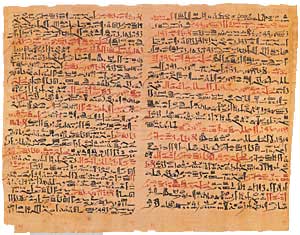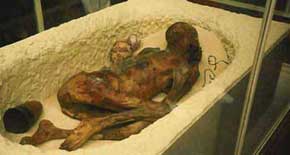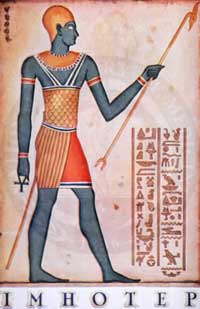Ancient Egyptians and the Study of Medicine
Knowledge of Egyptian medicine comes chiefly from two documents, the Ebers Papyrus and the Smith Papyrus. These date from the mid-2d millennium BCE but codify much older knowledge. The Ebers Papyrus details not only the incantations to be used for specific illnesses but lists many practical remedies. Drug treatments include the use of castor oil as a laxative and willow leaves and bark (which contained acetylsalicylic acid, the active ingredient in aspirin) to speed healing. The Smith Papyrus gives detailed case reports and describes the removal of cysts, male circumcision, bone-setting, and staunching bleeding by pressure.
 Image courtesy of New York Academy of Medicine [1], |
Surgical case histories are inscribed on this ancient Egyptian papyrus that was sold to antiquities collector Edwin Smith in 1862. Procedures described here include treatment of head wounds and broken bones. |
Egyptians presumably learned a lot about human anatomy because of their practice of mummifying bodies. The papyri show that they understood the functions of most major organs, though they had roles of the heart and brain reversed. The Egyptians believed that the brain pumped blood and the heart controlled the feelings and thoughts.
|
Image courtesy of www.ihistory101.net/ [2]. Egyptian physicians learned about human anatomy from the mummification process. The major organs were removed during the process, and ancient physicians accurately described the functions of most organs. |
Medical practice was highly organized, at least for society’s elite. Physicians called swnu specialized in particular organs of the body or diseases. Some, for example, dealt with the eyes, some the teeth, and some the intestines. There were female swnu. Records from the mid 3rd millennium BCE describe a person called Pesheshet as the "lady overseer of the female physicians." This is the first historical reference to doctors who were women. Sorcerers were another class of healers.
|
Image courtesy of National Library of Medicine [3]. Imhotep was a priest-physician to ancient Egyptian pharaoh Zoser. He was so respected as a physician that he was given divine status, with shrines to him. |
At the top of the hierarchy were the priest-physicians. The most celebrated was Imhotep, who served as chief vizier to the pharaoh Zoser in the early 3d millennium BCE. He was a priest and astrologer, a designer of pyramids, and renowned as a physician. Imhotep was later given divine status. The shrines associated with his worship became healing centers.
In nearby Mesopotamia [4], a similar system developed, with spiritual and practical healers playing different roles.
This content has been re-published with permission from SEED. Copyright © 2025 Schlumberger Excellence in Education Development (SEED), Inc.


